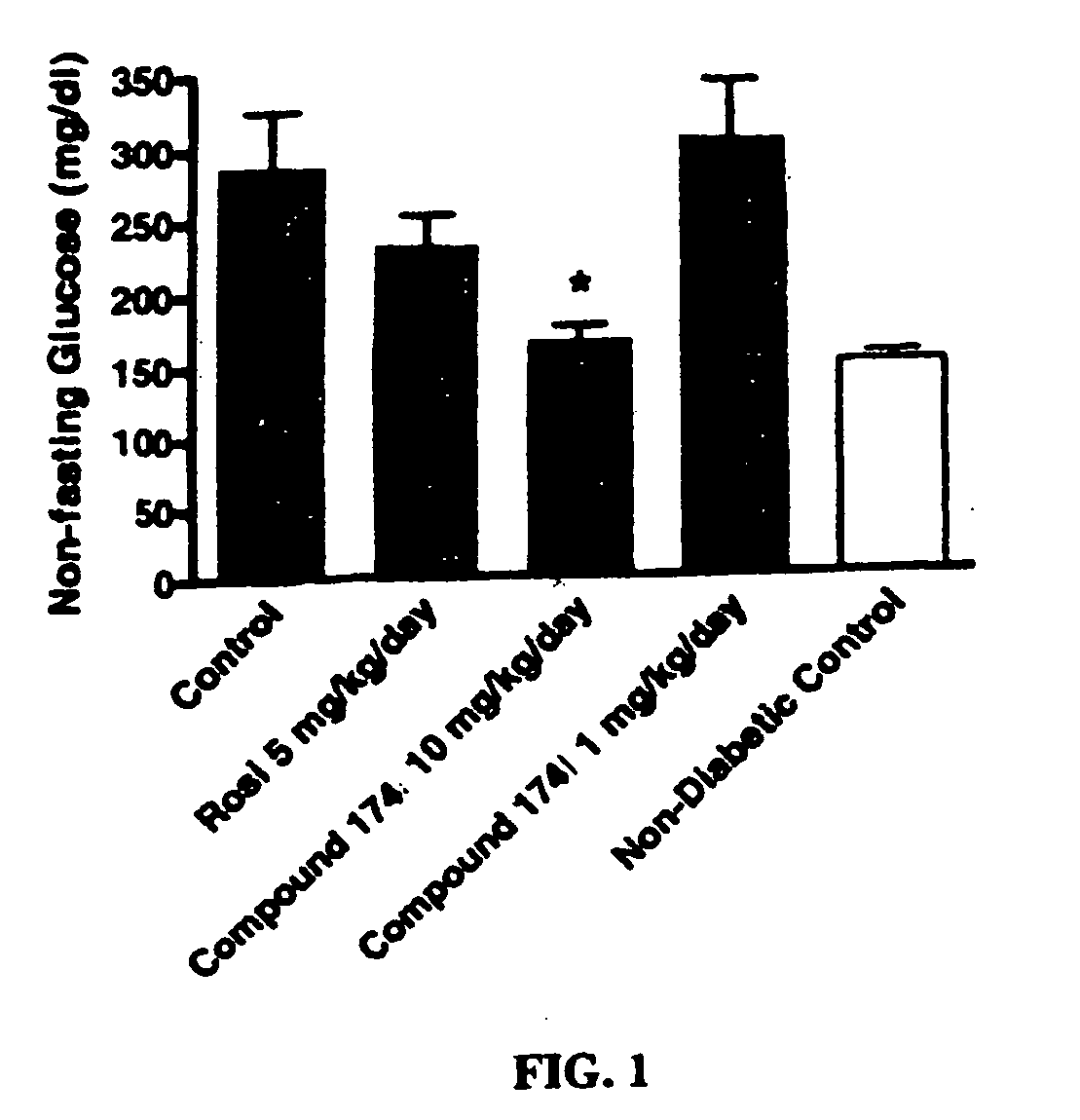Benzimidazole derivatives and methods of use thereof
a technology of benzimidazole and derivatives, applied in the field of benzimidazole derivatives, can solve the problems of increased and premature morbidity and mortality, increased risk of macrovascular and microvascular complications in diabetic patients, and increased risk of plasma insulin levels
- Summary
- Abstract
- Description
- Claims
- Application Information
AI Technical Summary
Problems solved by technology
Method used
Image
Examples
example 1
Preparation of Intermediate Compound A
[0191]
Step 1—Synthesis of Compound A1
[0192]
[0193]To a solution of 2-amino-4-methylpyridine (10.81 g, 100 mmol) in tert-butanol (250 mL) was added t-BOC anhydride (26.19 g, 120 mmol). The reaction mixture was stirred at 23° C. for about 15 hours, and then concentrated in vacuo. The crude oil obtained was dry loaded onto a silica gel column and flash chromatographed (eluant: 30% hexanes-CH2Cl2 to 0-2% acetone-CH2Cl2) to provide 15.25 g (73.32 mmol; 73%) of compound A1 as a white solid.
Step 2—Synthesis of Compound A2
[0194]
[0195]To a solution of compound A1 (35.96 g, 173 mmol) in TI-IF (1.41) at −78° C. was added n-BuLi (1.4 M in hexanes, 272 ml, 381 mmol) portionwise over 30 minutes. The reaction mixture was then allowed to warm slowly and was stirred for 2 h at 23° C., which resulted in the formation of an orange precipitate. The mixture was then cooled back to −78° C., and pre-dried oxygen (passed through a Drierite column) was bubbled through th...
example 2
Preparation of Intermediate Compound B
[0201]
Step 1—Synthesis of Compound B2
[0202]
[0203]A solution of diamine 1B (see Example 1, Step 1) (20 g, 71.1 mmol) and Et3N (30 ml, 213 mmol) in CH2Cl2 (400 mL), was cooled to 0° C. in an ice-water bath with stirring. To the stirred solution was added triphosgene (14.2 g, 47.3 mmol) cautiously (exotherm!) and portionwise over a period of 30 minutes. When addition was complete, stirring was continued at 0° C. for 1 h, then at room temperature for 16 hours. The mixture was washed with 0.5N NaOH (200 mL), the organic layer was dried over anhydrous MgSO4 and concentrated in vacuo. Hot EtOAc (200 mL) was added to the semi-solid residue, and the resultant mixture was cooled to room temperature. Filtration yielded compound B2 as a white solid (16.5 g); and silica gel flash chromatography [CH2Cl2—CH3OH (2N NH3)=40:1] of the filtrate provided additional product as a white solid (2.7 g) [combined yield: 88%]. FABMS: 308 (MH+; 100%).
Step 2—Synthesis of Co...
example 3
Preparation of Intermediate Compound C
[0210]
Step 1—Synthesis of Compound C1
[0211]
[0212]NaH (60 mg of a 60% dispersion; 1.48 mmol) was added to CH3OH (4 mL) in a flask charged with N2. After stirring at room temperature for 30 min, compound B3 (400 mg, 1.23 mmol) was added, and the resultant mixture was stirred at room temperature for 16 hours. CH3OH was removed in vacuo, and to the residue obtained was added CH2Cl2 (30 mL) and water (10 mL). The organic layer was dried over anhydrous MgSO4, filtered, and concentrated in vacuo. The residue obtained was purified using flash chromatography on silica gel, eluting with EtOAc-hexanes (3:2) to provide compound C1 as a white foam (0.232 g; 59%). ES-MS: 322.1 (MH+; 100%).
Step 2—Synthesis of Compound C
[0213]1N aqueous KOH (4.82 mL; 4.82 mmol) was added to a solution of compound C1 in EtOH (15 mL), and the resultant mixture was stirred at 80° C. for 48 hours. The mixture was concentrated in vacuo and water (3 mL) and CH2Cl2 (15 mL) were added ...
PUM
| Property | Measurement | Unit |
|---|---|---|
| temperature | aaaaa | aaaaa |
| temperature | aaaaa | aaaaa |
| pH | aaaaa | aaaaa |
Abstract
Description
Claims
Application Information
 Login to View More
Login to View More - R&D
- Intellectual Property
- Life Sciences
- Materials
- Tech Scout
- Unparalleled Data Quality
- Higher Quality Content
- 60% Fewer Hallucinations
Browse by: Latest US Patents, China's latest patents, Technical Efficacy Thesaurus, Application Domain, Technology Topic, Popular Technical Reports.
© 2025 PatSnap. All rights reserved.Legal|Privacy policy|Modern Slavery Act Transparency Statement|Sitemap|About US| Contact US: help@patsnap.com



